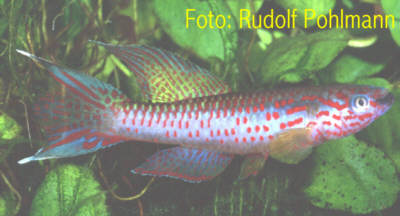| Meaning
of Name |
After Herr Riggenbach who first collected the
species.
|
| First
Description |
Ahl E. 1924. Fundulus
riggenbachi
Neue afrikanische Zahnkarpfen aus dem zoologischen Museum Berlin.
Zoologischer Anzeiger 61 (3-4): 135-145: p 142-143.
Ahl used 4 fish in his description.
|
| Size |
Males 7cm, females 5cm.
|
| Meristics |
- D = 11-13, A = 11-13, ll = 26-28 (Ahl 1924)
- D = 12-14, A = 13-15, ll = 26-29 (Radda &
Pürzl 1987)
- D = 13, A = 14, D/A = 4, ll = 28 (Huber in
Killidata)
|
| Karyotype |
- n = 10-19, A = 34-38 (Scheel 1974)
- n = 10, A = 34 (Huber in Killidata).
- Variability from 2n = 20 to 2n = 38 (Agnèse
2006)
|
| Sub-Genus |
Chromaphyosemion
|
| Group |
|
| Synonyms |
- Fundulus riggenbachi Ahl
1924
- Fundulus bivittatus
(non Lönnberg 1895) Pellegrin 1929
- Aphyosemion riggenbachi
Myers 1933
- Aphyosemion riggenbachi BIV-GI
- Aphyosemion riggenbachi BIV-YA
- Aphyosemion bivittatum
riggenbachi Lazara 1979
|
|
Populations
- Bonépoupa 2
- Cellucam
- Dibamba (Nyam Tam)
- Dibeng
- Dibombe
(An isolated population at the northern edge of distribution)
- Dibini
- Henda River - HLM 18/99
- Kondé
- Makemba-Souza
- Mandjap
- Ndokama 1
- Ndokama PK 12 & PK 15
- Ndokpo
- N'kapa
(Discovered by Poliak & Chauche about 16 km west of the Wouri
River) Amiet 1987 considered this location to be the western limit
of the sp. distribution area although more work was needed in this
direction)
- Nkokem
- Nkondjok
(misspelt Nkondjock)
- NKWO - 97 / 1
(Possible
corruption NKWO 78/1)
- Quelle (Yabassi)
- Ruisseau Séla
- Solé
- Somakak
- Song Makak
- Tibéti
- Vari North
- Yabassi
- ABC 05 / 18 -
13 km south of Edea-Yabassi crossroad
- ABC 05 / 19 - Nkouli-Ngnock
- C 89 / 18 -
20km north of Bonépoupa
- C 89 / 19 -
16km north of Bonépoupa
- C 89 / 23 Cellucam
- C 94 / 1
- CMG 23 / 5 -
Ham
- HAH 98 - Bonepoupa
- HJRK 92 / 18 Ndokama
- HJRK
92 / 19 Ndokama
- KPI 89
- PK 12 Ndokama
- PK 15 Ndokama
|
|
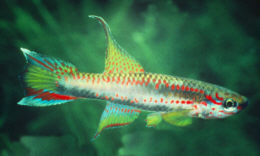
Form circulating
in the BKA in the '70's.
BKA photo.
|
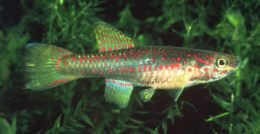
Female to the
male shown on the left.
BKA photo.
|
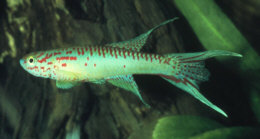
Form known to
have been in the BKA in the '70's.
BKA photo.
|
|
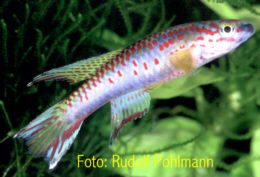
C 94 / 1
|
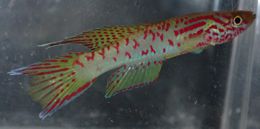
CMG 23 / 5 - Ham
Photo courtesy of Vasco Gomes
|
|
Dibeng -
|
.jpg)
Dibeng
F2 Gold
Photo courtesy of David Baker
|
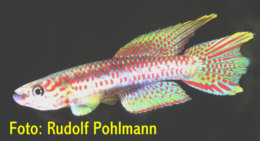
Dibeng.
Photo courtesy of Rudolf Pohlmann.
|
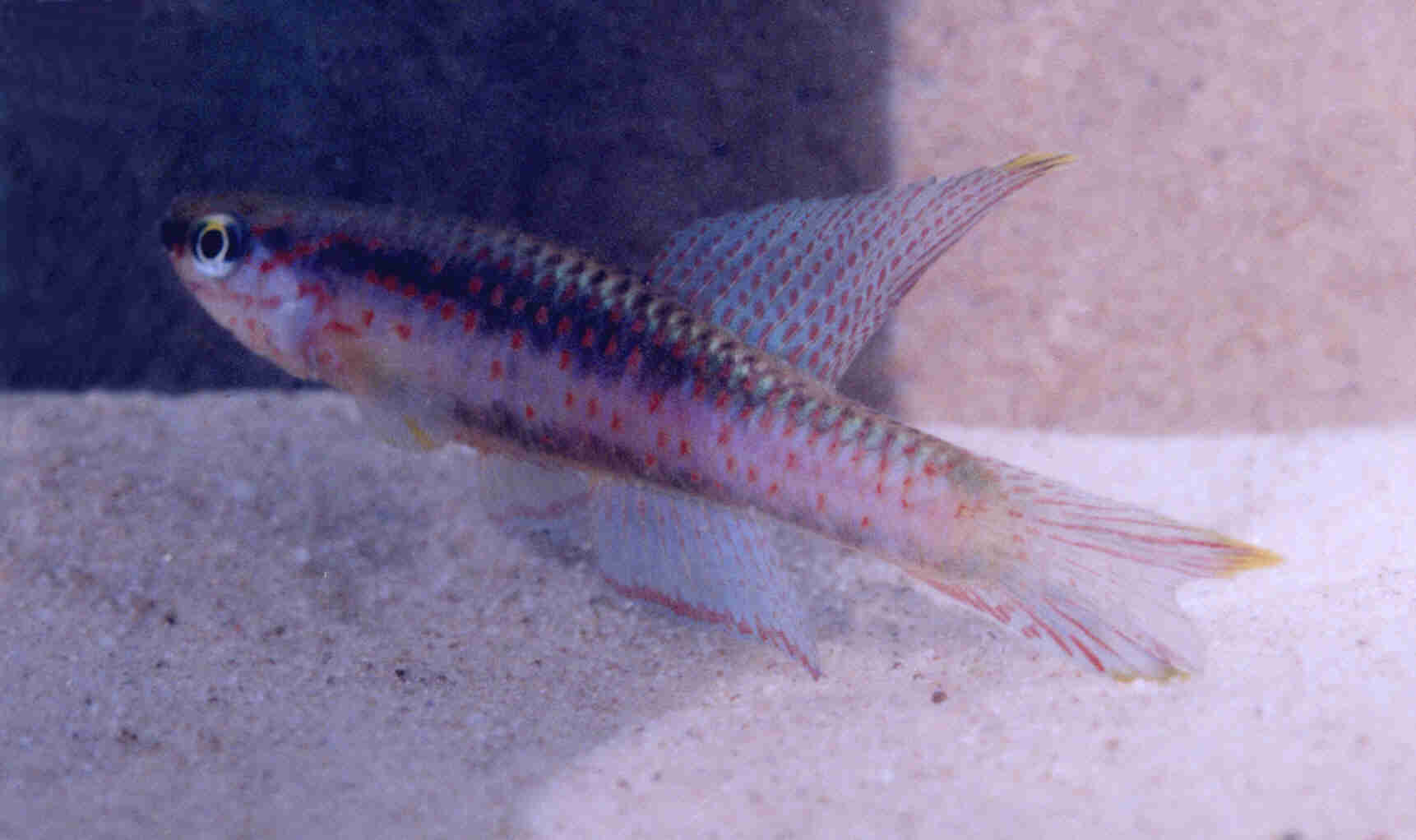
Dibeng
imported 2001 to England in commercial shipment. This blue form,
the gold & intermediate form below were caught in the same
area according to collectors information.
|
|
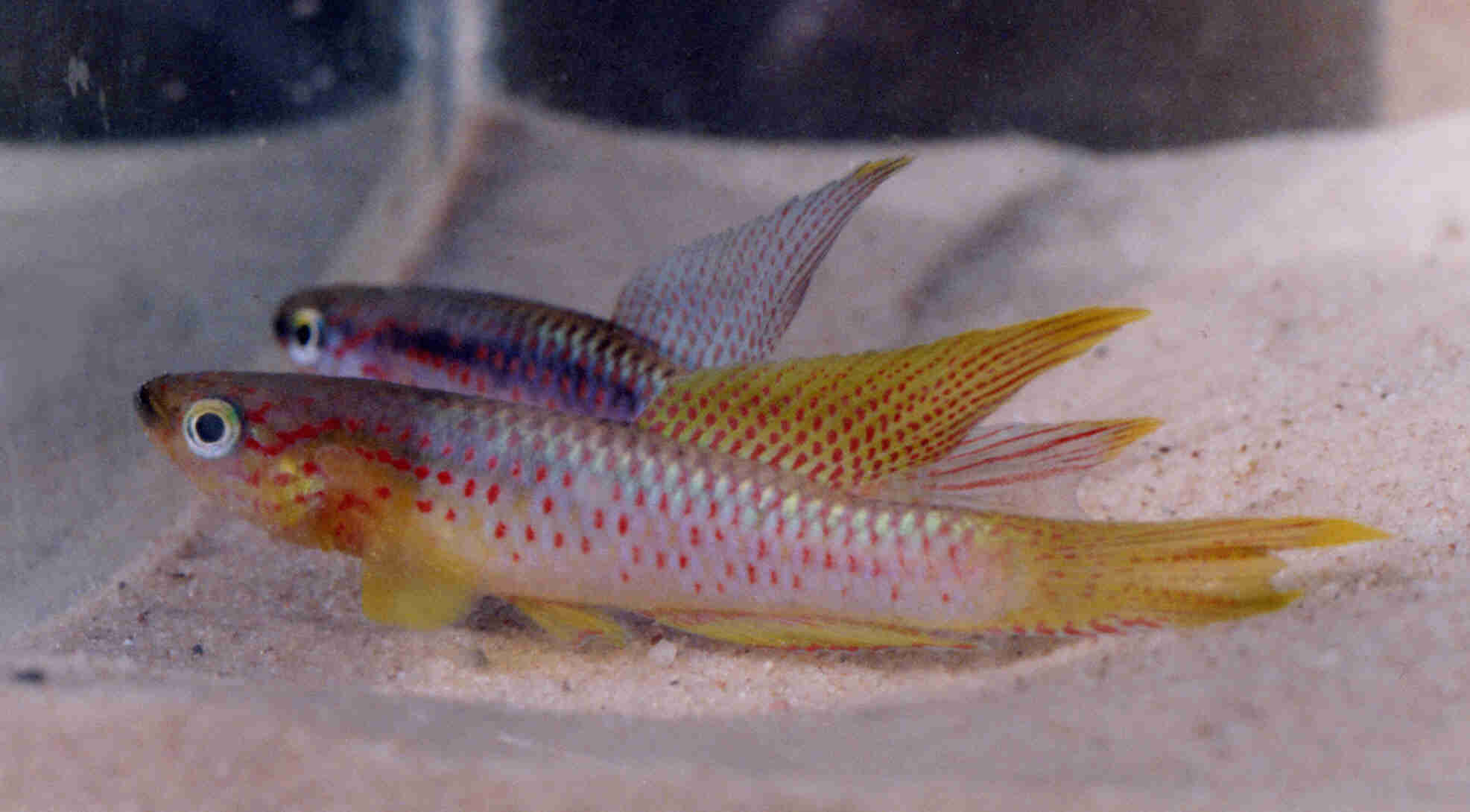
Dibeng
Gold. Wild fish.
|
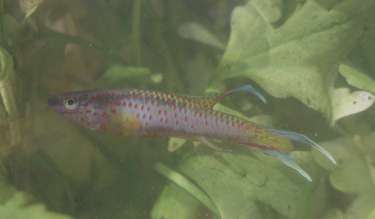
These arrived
in poor condition. Many fish died in transit from Cameroon or
were too weak to pull round which died in the first couple of
days. Some of these had dull orange caudal extensions as opposed
to the white/pale blue in the fish which survived. We only had
2 fish survive. No code assigned.
|
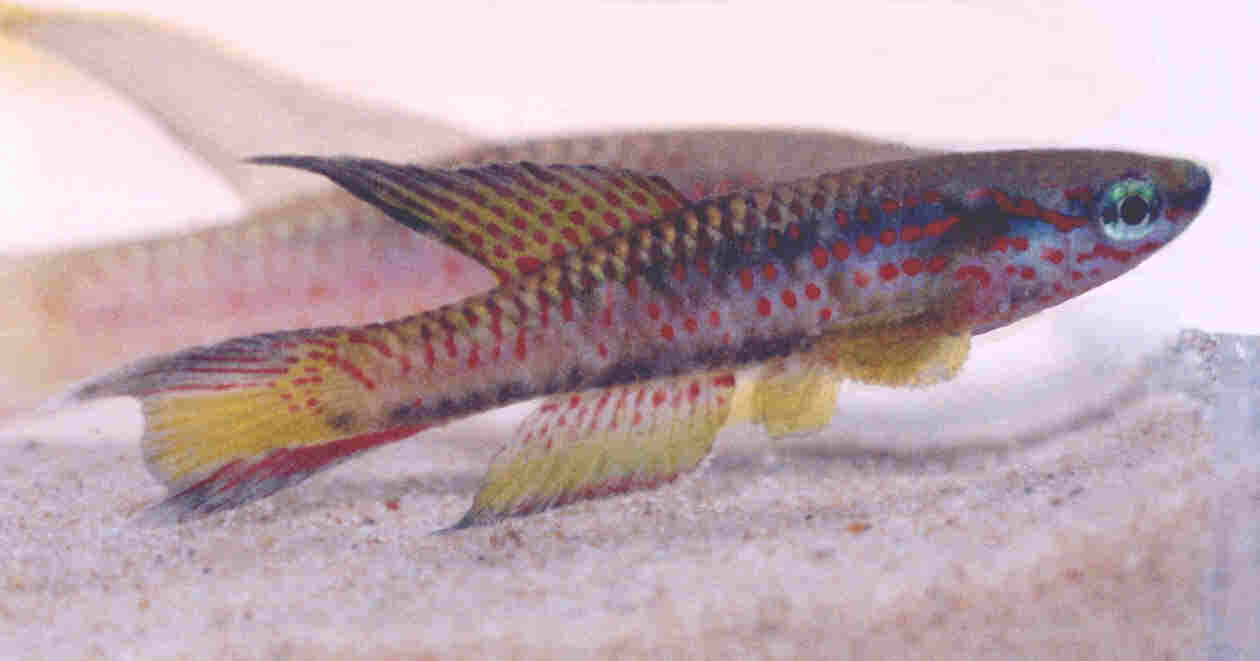
Dibeng
Intermediate. Wild fish showing both blue & yellow colouration.
See blue photo above.
|
|
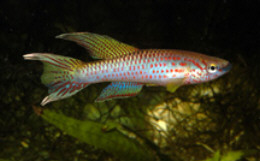
Two year old
wild male from a Dibeng commercial import to the AKA. This form
was reportedly distributed as Yabassi on first import.
Photo courtesy of Tony Terceira
|
|
|
| |
|
|
Bonepupa HAH 98 -
http://www15.brinkster.com/runo7/rig2.htm
Nonn Pantivong's site.
Ndokama -
|
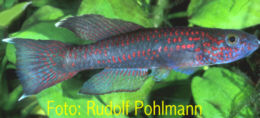
NDOKAMA HJRK 92 / 19.
Photo courtesy of Rudolf Pohlmann.
|
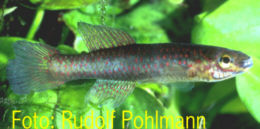
NDOKAMA HJRK 92 / 19
female.
Photo courtesy of Rudolf Pohlmann.
|
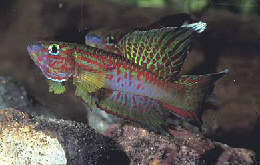
Ndokama PK 12
Photo courtesy of Günther
Schmaus.
|
Nkapa -
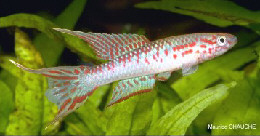
Nkapa
Photo courtesy of Maurice Chauche & the
KCF website.
|
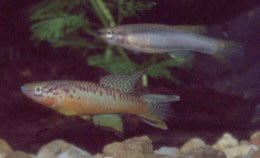
YABASSI pair.
Photo courtesy of Ed Pürzl
|
|
Nkokem -
|
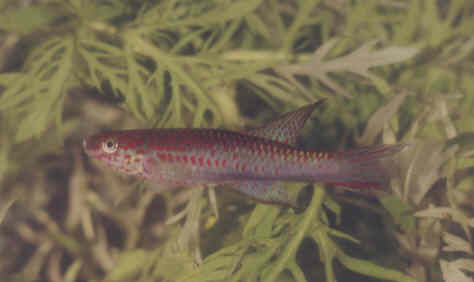
Nkokem. Taken early
80's UK
|
|
|
NKWO 97 / 1 -
|
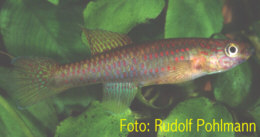
NKWO 97 / 1, female
F1 generation.
Photo courtesy of Rudolf Pohlmann.
|
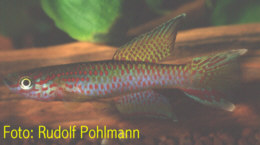
NKWO 97 / 1, male
F1 generation.
Photo courtesy of Rudolf Pohlmann.
|
|
Somakak -
http://www.nakashima.org/ga_riggen_so.htm
Japan Gallery
Yabassi -
David Astbury wrote a report on this population
in BKA newsletter No. 182, October 1980. This population was collected
in January 1979 in a narrow stream 24 km from the Douala - Edea crossroads
in the direction of Yabasso (Yabassi ?). The fish were collected away
from the banks under plants & overhanging vegetation. Water temperature
21° C, pH 6·5, electrical conductivity 40 microsiemens. Fp.puerzli
was also found in this biotope.
|
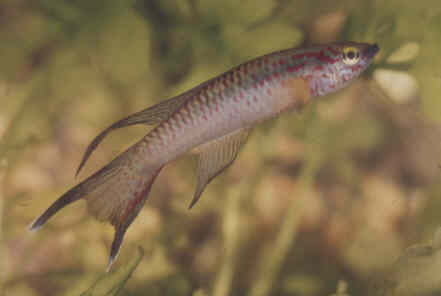
Yabassi. Photo
taken early 1980's
|
|
|
Other collections at Yabassi -
- KV 03 / 28
- KV 03 / 29 - towards Loum
|
| Type
Locality |
A spring close to Yabassi, western Cameroon.
This has also been spelt 'Jahassi ' & 'Jabassi' in previous literature.
|
| Distribution |
Western Cameroon in the Lower & middle reaches
of the Wuri, Dibamba & Sanaga River drainage systems. This is the
second largest distribution area of the subgenus.
Amiet 1987 found them at Nkondjock which
is by the foot of the Bamileke Plateau representing the northern edge
of distribution. He fished at Fopouanga on the south side of the plateau
but failed to find them.
The eastern limit has yet to be defined
in Amiet 1987 but it was thought to be at the natural barrier of the
Ouem River.
The Sanaga River to the southeast in the
lower drainage area was considered to be the edge of the sp. distribution
in this direction but Amiet 1987 verified that they were 'abundant'
near the sources of the Kondé River which is a small eastern
bank tributary of the Sanaga River.
The southern limit appears to be the old
Douala - Edéa road. From here they are replaced by A.loennbergii.
Replaced to the coast in the west by A.splendopleure.
Amiet 1987 found A.riggenbachi
in a stream 'quite close to a river' which was inhabited with A.loennbergii
at Dibombe.
|
| Habitat |
Coastal rainforest streams & brooks flowing
over ancient basement rocks & sand. Depth of water is reportedly
30 cm. Water temperature 22-32°C. They are found sympatrically with
Fp.puerzli, Fp.amieti
& A.franzwerneri
also.
|
| Distinguishing
Characteristics |
Size, this species is the largest of the Chromaphyosemion
subgenus. According to Amiet 1987, the background colouration on the
body has no metallic reflections, being green, blue, turquoise generally
but occaisionaly yellow/green or mauve/violet.. The fine red carmine
red punctuations are more noticeable than other species in the subgenus.
All the populations I have kept over the years
have seemed drab in colouration & never showed themselves off as
other species in the subgenus.
Huber in Killidata
considers a method to seperate the species by the outer marginal band
of the anal fin & the submarginal band of the caudal fin. Both being
red.
Also, females are reported as lacking the distinctive 2 black horizontal
lines in females.
This line is reportedly grey. I do not completely hold with this point
of distinction as I have seen females with 2 bands. A photo above of
Yabassi illustrates this.
|
| Colour/Pattern
Variability |
Medium |
| History |
Ahl described the species in 1924 from 4 specimens
collected near Yabassi, eastern Cameroon. Holly examined the type specimens
& changed some of the data in his redescription of 1930. These types
were described as being 'a uniform yellow, with rows of faint spots
in some of the fins' (ROTOW
1).
Scheel in BKA newsletter 76, December 1971 mentions
populations BIV-GI (collected 25 km north of the junction) & BIV-YA
(collected 15-17 kms north of the junction). The BKA had in circulation
in 1971 the BIV-YA population which, according to Scheel was not as
colourful the other population mentioned. This BIV-GI population soon
became extinct in aquaria.
First distributed in the BKA in October 1972
from a BKA import containing 2 pairs.
|
| Breeding
Notes |
Water incubation takes 15-18 days. Growth rate
is a little slow with sexual maturity being attained at about 7 months.
It has been reported that some young males can start to show colouration
at the age of 3 months.
The first introduction to the BKA seemed to prove
difficult in that a high proportion of eggs would fungus when collected.
The natural method of leaving the eggs in the breeding tank proved more
successful. It was reported at the time that young fish seemed to stop
growing around 1" & later started growing again. Full maturity
was observed to be about a year.
Dave Astbury's article mentioned in 'Populations'
gives a report on breeding the Yabassi population..
He found this fish rather inactive & despite their size placed them
into a 12x8x8" tank. Rainwater was added with a teaspoonful of
salt per gallon. A clump of Java moss was placed in the centre with
Riccia & Ceratopteris
as floating plants. He recommended changing 20% of the water each fortnight.
For general maintenance 21°C is OK but for breeding a rise to 23°C
is recommended. Eggs are laid in the Java moss & can be collected
& placed in seperate tubs with fresh rainwater. It was noted that
the addition of Acriflavine or other anti-fungicides were lethal to
the eggs & would kill them overnight.
In this setup Dave collected 50-60 eggs weekly. Eggs hatched in 10-12
days. The fry have a yolk sac for 3-4 days. Infusoria was fed for the
first few days graduating on to newly hatched brine shrimp.
Huber, in Killidata
considers a wet incubation period of 3 weeks. First food can be newly
hatched brine shrimp. First signs of sexing out noticed at 12 weeks
with full maturity gained at 8 months.
Oliver Legros in BKA Newsletter No. 318 (March
1992) considered A.riggenbachi the
slowest to sex out of all other then known Chromaphyosemion.
The was particularly seen in the Yabassi population.
I had some wild fish in collected at Yabassi,
December 2022. About 11 males & 3 females. These were put in a 2
foot square tank on system so water was continually being put into the
tank at quite a high rate. The fish were quite happy with this &
quickly grew on to a point they started laying eggs in a top mop. At
first a lot went fungussed. As time went on fewer were lost & it
became rare to find a bad egg.
The mop was also left to drop to the bottom of the tank but no difference
in the amount of eggs produced. Five a day was the norm. I found the
mop one day had been dragged by the water movement into the stream of
water entering the tank. Egg production went up to around 20. This went
on over the next few days with the mop in the same place.
As the fish became established fry started to appear in the tank &
grew on unmolested by the adults.
|
| Diameter
of Egg |
1·3
- 1·5mm. Some reports state 1·4 - 1·6mm. |
| Remarks |
Whilst many populations of this sp. have proved
difficult I found the wild (& F1) Dibeng proved very easy to breed.
|
